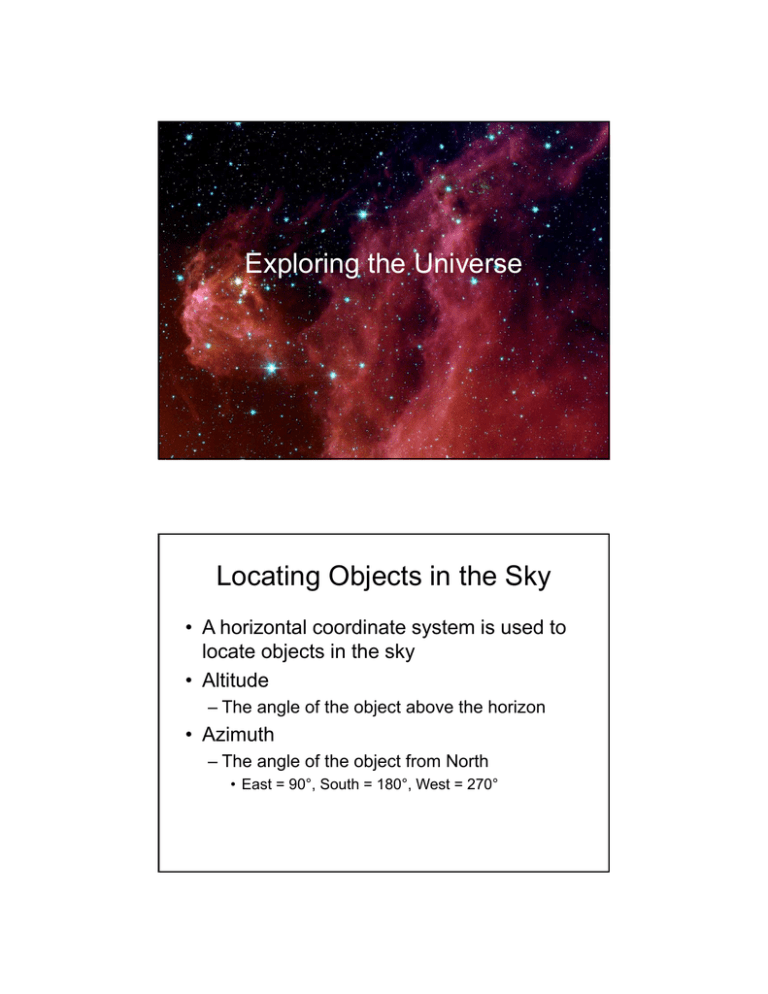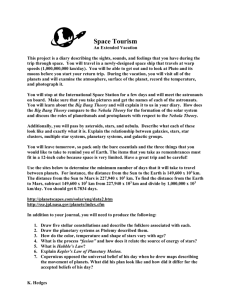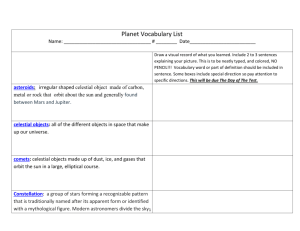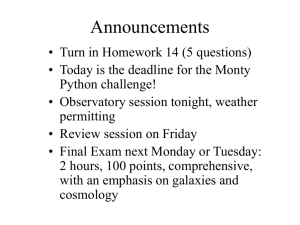Exploring the Universe Locating Objects in the Sky
advertisement

Exploring the Universe Locating Objects in the Sky • A horizontal coordinate system is used to locate objects in the sky • Altitude – The angle of the object above the horizon • Azimuth – The angle of the object from North • East = 90°, South = 180°, West = 270° • These numbers depend on where you are – Where the horizon is depends on your latitude Instruments Front of Fusoris astrolabe (Photo courtesy Adler Planetarium and Astronomy Museum) Quadrant Mariner’s Astrolabe Motion of Visible Celestial Objects • The Earth rotates about its axis • The Earth revolves around the Sun • Therefore, celestial objects are going to appear at different places at different times Retrograde Motion • Planets appear to travel backwards during part of their journey across the sky – Called Retrograde motion Geocentric Universe • Proposed by Ptolemy and Aristotle • Earth was considered to be at the center of the universe • Planets, the Sun, and the Moon rotated around the Earth • The stars were on a “celestial sphere” that rotated around the Earth • Based on two observations – The Sun, moon and planets appear to go around the Earth – The Earth does not appear to move Heliocentric Universe • Not everyone thought that the Earth was the center of the universe – Pythagoras’ theory was that Earth and the other planets revolved around a big fire – Aristarchus of Samos proposed a suncentered universe (but no one accepted his idea) • Biggest challenge to the geocentric theory was Copernicus in 1543 • Copernicus proposed a heliocentric universe – Sun was stationary and everything else revolved around it • The heliocentric theory was expanded on by Kepler (mathematical basis) • Galileo made observations supporting the theory • Herschel made observations that showed that the Sun was not the center of the universe • Hubble (1920s) showed that the sun was just another star in a massive galaxy Measuring Distance in Space • The universe is huge • The distances between planets is large and the distances between stars is even greater • Astronomers have developed units of distance to make the numbers managable Astronomical Unit • AU, au, or a.u. • Represents the distance between the Sun and the Earth • 1.5x108 km • Neptune, for example, is 4.5x109 km from the sun or 30 AU Light Year • ly • The distance light travels in one year – 9.5x1012 km • Used to measure the distance to stars and other objects outside of our solar system • The nearest star outside of our solar system is Alpha Centauri – 41.5x1012 km = 277 600 AU = 4.37 ly Parsec • pc • Used to measure distances to stars • 3.26 ly – 3.1x1013 km Components of the Solar System • The major components of the solar system – Planets – Moons – Comets – Asteroids – Nebulae – Stars – Galaxies – Black holes Planet • The ancient Greeks used the term to refer to stars that wandered across the sky • Modern definition – A celestial body that: • is in orbit around the Sun • has sufficient mass for its self-gravity to overcome rigid body forces so that it assumes a hydrostatic equilibrium (nearly round) shape • has cleared the neighborhood around its orbit Moon • A natural satellite or moon is a celestial body that orbits a planet or smaller body Comet • A comet is an icy small Solar System body that, when close enough to the Sun, displays a visible coma (a thin, fuzzy, temporary atmosphere) and sometimes also a tail • Comets have a wide range of orbital periods, ranging from a few years to hundreds of thousands of years • As of January 2011 there are a reported 4,185 known comets • A comet is distinguished from an asteroid by the presence of a coma or tail Halley's Comet, named after the astronomer Edmund Halley for successfully calculating its orbit. (1910) Comet Hale–Bopp, as seen on 29 March 1997 in Pazin, Croatia Asteroid • Asteroids are a class of small Solar System bodies in orbit around the Sun • Typically an asteroid refers to small rocky and metallic bodies of the inner Solar System out to the orbit of Jupiter Nebula • A nebula is an interstellar cloud of dust, hydrogen gas, helium gas and other ionized gases • Often considered star-forming regions – The formations of gas, dust, and other materials "clump" together to form larger masses, which attract further matter, and eventually will become massive enough to form stars, planets, and other planetary system objects Crab Nebula (NASA/ESA) Horsehead Nebula (NASA/ESA) Cat’s Eye Nebula (NASA/ESA) Star • A star is a massive, luminous sphere of plasma held together by gravity • The closest star to the Earth is our Sun • For part of its life, a star shines due to thermonuclear fusion of hydrogen in its core releasing energy Galaxy • A galaxy is a massive, gravitationally bound system that consists of stars and stellar remnants, an interstellar medium of gas and dust, and an important but poorly understood component tentatively dubbed dark matter A view of the Milky Way towards the Constellation Sagittarius (actually the Galactic Center) as seen from a non-light polluted area (the Black Rock Desert, Nevada) (Steve Jurvetson) NGC 4414, a typical spiral galaxy in the constellation Coma Berenices, is about 55,000 light-years in diameter and approximately 60 million light-years away from Earth. (NASA/ESA) Black Hole • A black hole is a region of spacetime from which nothing, not even light, can escape • The theory of general relativity predicts that a sufficiently compact mass will deform spacetime to form a black hole • It is called "black" because it absorbs all the light that hits the horizon, reflecting nothing • The first modern solution of general relativity that would characterize a black hole was found by Karl Schwarzschild in 1916 • During the 1960s theoretical work showed black holes were a generic prediction of general relativity • The discovery of neutron stars suggested that black holes were possibly real • Black holes are expected to form when very massive stars collapse at the end of their life cycle






